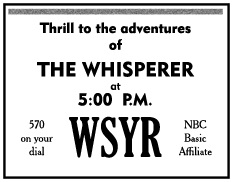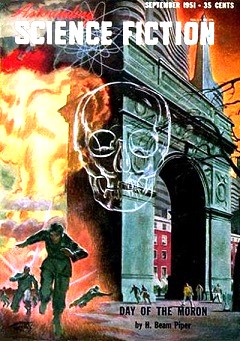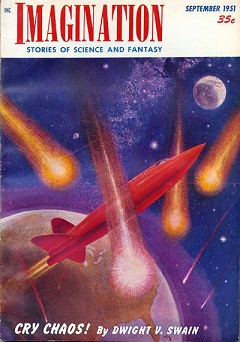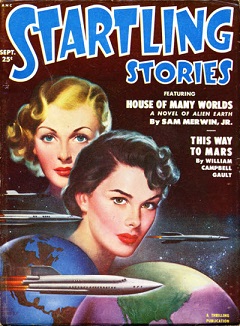
 The Whisperer (1951) aired “The Police Lieutenant” on September 23, 1951 as the twelfth of its 13 episodes. This episode is only the second we have showcased since the first back in October of 2022, so a reprise of the introductory comments from that premiere episode is in order for newcomers.
The Whisperer (1951) aired “The Police Lieutenant” on September 23, 1951 as the twelfth of its 13 episodes. This episode is only the second we have showcased since the first back in October of 2022, so a reprise of the introductory comments from that premiere episode is in order for newcomers.
The man known as the Whisperer is in reality one Philip Galt, a lawyer who was in a terrible accident in which his vocal chords were crushed. He used this strange disability as a cover to infiltrate the organized crime Syndicate in Central City, passing on to this local crime affiliate their next crime or proposed illegal operation from the Syndicate’s national bosses in New York. Upon completion of a successful operation by Dr. Benjamin Lee and his nurse Ellen Norris that returned his voice, Galt decided to continue his undercover role as the Whisperer, setting up the local Syndicate branch and then foiling their crimes and getting them arrested, convicted, and behind bars as lawyer Philip Galt. Ellen Norris is now Galt’s assistant and love interest and is the only one who knows Galt doubles as the Whisperer.
Philip Galt/The Whisperer was played by Carleton G. Young (1907-1971, photo top right). He appeared in a number of radio shows, had roles in a number of films, and did quite a few TV shows into the early 60s.
In “The Police Lieutenant” the Whisperer finds himself in a real pickle. For some time and unbeknownst to the Crime Syndicate in New York, he has infiltrated their organization and is the liaison between it and the local crime syndicate branch in Central City. He passes on instructions from the main headquarters to the local branch, uses the inside information to thwart any such illegal enterprise, and then puts the perpetrators behind bars in his real life as Philip Galt, attorney. But this time the local branch’s orders are to eliminate Galt, the perennial thorn in the New York Syndicate’s side. There is some high falutin’ maneuvering and scheming involved in order to maintain Galt’s cover as the Whisperer, but in the end it boils down to him setting himself up as a decoy, knowing Syndicate assassins will be following his every move where there will be more than enough opportunities to take him out. And try they do, amidst a hail of gunfire, but somehow Galt manages to survive (with the help of a new technological advance). Thus ends only the first half of this taut thriller, as more intrigue and danger await Galt as secrets and subterfuge are revealed, making the odds for him staying alive ever slimmer. Get set for an exciting episode of The Whisperer and learn what role is played by “The Police Lieutenant.”
Play Time: 30:02
{Airing an early Sunday evenings in September of 1951, after listening to this episode of The Whisperer, the neighborhood gang would head for the nearby newsstand the next day after school to check the shelves for any genre SF titles they could add to their growing collections. Astounding SF (1930-present, now Analog) was always a certain purchase and this issue was no exception. Along with H. Beam Piper’s cover showcased novelette “Day of the Moron,” there were stories by Frank M. Robinson (a novella), J. A. Meyer, and Alan E. Nourse. ASF was a monthly in 1951. Imagination (1950-58) began as another of Raymond A. Palmer’s numerous startups, but was sold to William Hamling after its second issue. It ran for 63 issues, much longer than many another SF magazine trying to get its foot in the publishing door at that particular time due to the collapse of the distribution industry. While not regarded well by most critics, it did manage to publish material from the likes of Robert Sheckley, Philip K. Dick, and Robert A. Heinlein. Its schedule was bi-monthly, though it skipped an issue and only saw 5 issues in 1951. Startling Stories (1939-55) was one of the few remaining SF pulps from SF’s first magazine golden age of the 1930s-’40s. Along with Planet Stories (1939-55) and Thrilling Wonder Stories (1936-55) it published wildly imaginative adventure stories, heavy on action and storyline and light on accurate science, that nevertheless lit up the imaginations of the youthful audience it sought to capture. Many of its stories are now regarded as classics and have been often reprinted, while the authors of these tales went on to become either some of the most beloved in the field, the most famous or award-winning writers in the field, or both. It was a bi-monthly in 1951.}
[Left: Astounding SF, 9/51 – Center: Imagination, 9/51 – Right: Startling Stories, 9/51]



To view the entire list of Old Time Radio episodes go here.